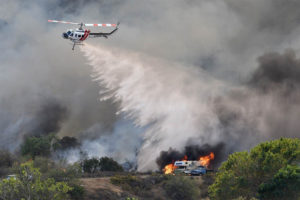How a 2016 wildfire impacted an entire region | Leveraging Opportunity Zones for Resilience
This post is a part of our series on private infrastructure resilience – or lack thereof – during major disasters. Learn more here.
The Blue Cut Fire began on the morning of August 16, 2016 in the Cajon Pass, a mountain pass in San Bernardino County, just west of the Interstate 15 highway. When it was first reported just before eleven in the morning, the fire was only two acres; by nighttime, it had reached 18,000 acres. Flames traveled up a mountain slope to a point where the wind could carry embers over the highway, prompting the closures of portions of Highway 138 and both sides of I-15. California Governor Jerry Brown declared a state of emergency for San Bernardino County on August 16 after the fire had burned 15,000 acres in under 12 hours. The following evening, 82,000 residents had been forced to evacuate from their homes and by August 19 fire officials estimated that 96 homes had been destroyed by the fire.

There are two companies operating transmission lines in the Cajon Pass: Southern California Edison (SCE) and the Los Angeles Department of Water and Power (LADWP). SCE announced that 683 customers in the vicinity of the fire were without power after hundreds of poles were damaged and suggested customers should prepare to be without power for several days. Damage assessment crews would later identify 384 electrical poles that had been damaged by the Blue Cut Fire.
The LADWP issued a statement regarding its transmission lines that run through Cajon Pass, directly in the path of the fire. Two LADWP transmission lines were interrupted, one of them to such a degree that it could no longer be used. The damaged lines were part of a transmission grid that supplies hydroelectric power to Los Angeles. To compensate for the energy deficit, LADWP utilized local basin generators, sparing Los Angeles from a major disruption. The sudden increase of gas-powered generation resulted in a 21 percent increase in natural gas demand, which required withdrawals from reserve storage facilities over five days. Since outages affect communications systems, Sprint volunteered to deliver charging stations to evacuation centers and to loan mobile devices with service included to agencies that were either impacted by the fire, or involved in recovery efforts.
When the I-15 closed due to the fire, it cut off the main route from Southern California to Las Vegas, trafficked by more than 5,000 cargo trucks daily. The closure forced truck drivers to choose between taking refuge at rest stops along I-15, or detouring hundreds of miles east or west of the interstate. Many truck drivers and motorists could not afford hotel accommodation and were unfamiliar with the back roads of the area; this left some stranded in their cars on the side of the interstate for the duration of the three day closure.
The fire also caused a 24 hour shut down of the Burlington Northern and Santa Fe (BNSF) Railway that created “a substantial backlog of traffic,” further delayed by safety measures such as 2 of the 3 service lines which had limited service. Shipments for BNSF customers were delayed for 36-48 hours. These railway disruptions resulted in the ports of Los Angeles and Long Beach halting operations for more than a day while crews worked to repair the damaged lines. Eric Sauer, vice president of the California Trucking Association, estimated the disruption to these ports would cost up to $1 million per day.
The Blue Cut Fire proved to be an example of cascading failures caused by naturally-occurring impacts to interconnected critical infrastructure. Though these infrastructure systems are all intertwined, owners and operators have limited incentive to invest in pre-disaster risk mitigation because the government typically insures disaster losses regardless of what preemptive actions they take. Ultimately, FEMA ended up covering the majority of the cost of firefighting for the Blue Cut Fire, though no federal public assistance was provided for individual victims of the fire. The dispute which followed regarded FEMA’s role in funding the costs of the fire, however the effects themselves may have been greatly mitigated had these infrastructure owners, as well as San Bernardino County, been more aware of their risks and more engaged in mitigating them risks prior to a disaster. Given the risk and losses to private industry posed by these disasters, private investment in disaster mitigation, especially through an Opportunity Fund which offers tax incentives, greatly limits liability during the next inevitable disaster.
